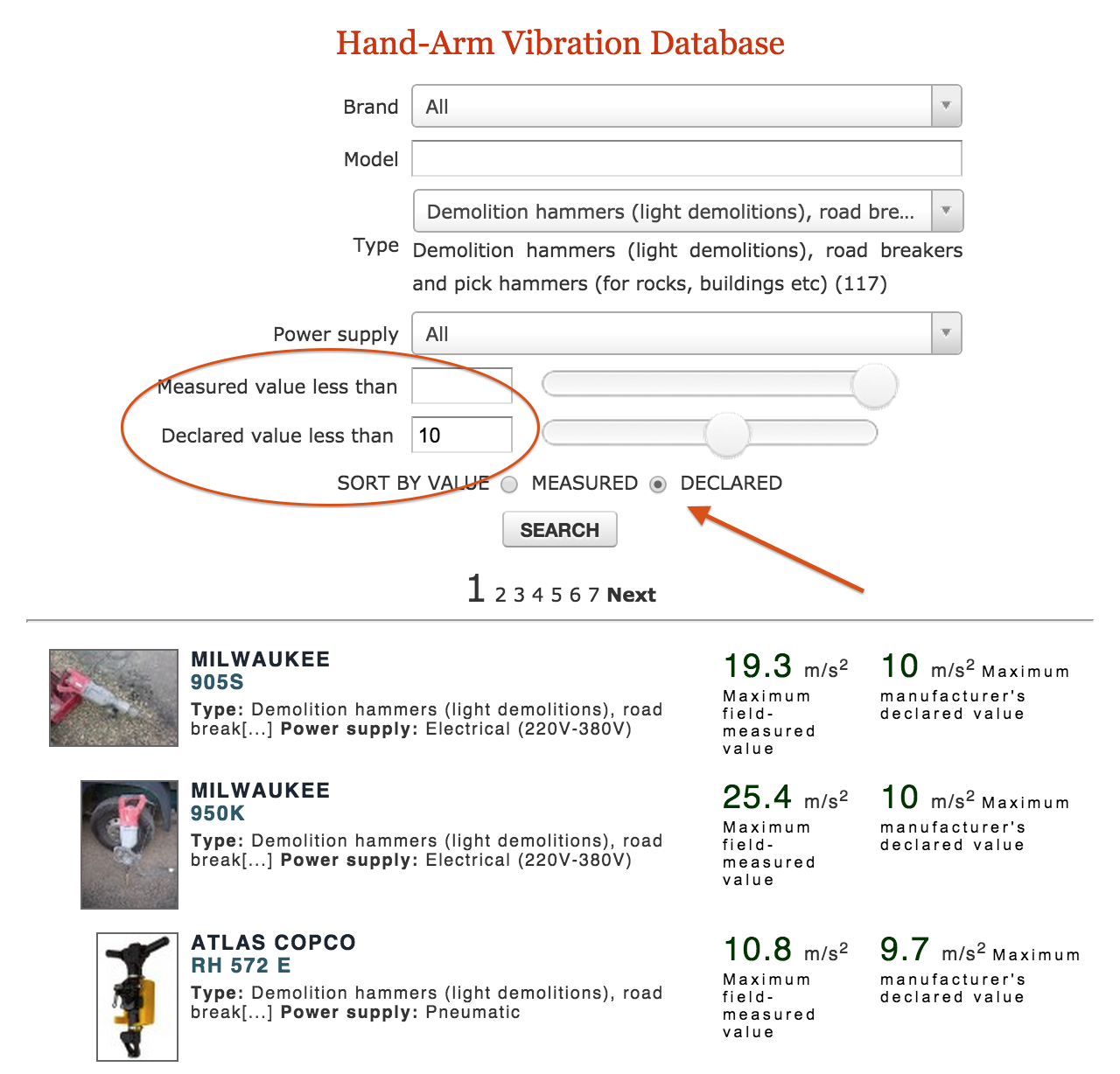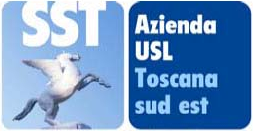Guide for using the Hand - Arm Vibration Database
The purpose of the Vibration Database is to:
- Ensure an easy retrieval of the values of exposure to vibration produced by widely used industrial equipment, in order to promote, as much as possible, the immediate implementation of interventions aimed at reducing the risk at source yet during the process of risk assessment, without having to recur to measures that can be expensive and complex. Indeed, the analysis of the possibilities of risk reduction, besides being a specific duty resulting from risk assessment in the case where the action levels are exceeded, represents an integral part of the risk characterisation and assessment process set down by the regulations. In this context, it is expressly stated by the regulations a particular attention should be given, when carrying out the risk assessment, to "information provided by the manufacturers of work equipment in accordance with the relevant Community Directives."
- Allow the employers and their consultants to identify the equipment that reduces to a minimum the risk arising from exposure to mechanical vibration, when purchasing new machinery or replacing the obsolete one.
- Support the manufacturers in designing and producing new machinery in full compliance with the Machinery Directive, as stated under section 1.5.9 (“Vibrations”), that reads as follows: “Machinery must be designed and constructed in such a way that risks resulting from vibrations produced by the machinery are reduced to the lowest level, taking account of technical progress and the availability of means of reducing vibration, in particular at source. The level of vibration emission may be assessed with reference to comparative emission data for similar machinery”.
The database is accessible separately for hand-arm transmitted vibrations (HAV) and whole body vibrations (WBV). Each machine has a link to a technical sheet, which provides a number of basic information such as: brand, model, type of power supply, power, weight, etc., a picture of the machinery itself and two types of vibration exposure data: those declared by the manufacturer within the meaning of the Machinery Directive (when available) and the field-collected data (if available) obtained by following specific measurement protocols that ensure the control of the uncertainty of results. In this case, the field measurement conditions and the contact person for the measurement are specified as well. The value reported in the database represents the mean of at least three repeated measurements performed on that machine under the operating conditions indicated on the sheet.
VIBRATION DATABASE: INDICATIONS FOR A CORRECT USE
The database provides two types of data:
- The emission values declared by the manufacturer within the meaning of the Machinery Directive;
- The vibration values measured in the field in accordance with specific international measurement standards (3,4).
Values declared by the manufacturer
Both the previous Machinery Directive (98/37/EC) and the current Machinery Directive (2006/42/EC) require that the vibration emission level of all the machines capable to produce vibration above the action levels set forth in the Vibration Directive shall be indicated in the instruction manual.
With reference to hand-held and hand-guided machinery, the current Machinery Directive establishes, in particular, that the information in the Instructions shall include:
- the vibration total value to which the hand-arm system is subjected, if it exceeds 2,5 m/s². Where this value does not exceed 2,5 m/s², this must be mentioned,
- the uncertainty of measurement.
These values must be either those actually measured for the machinery in question or those established on the basis of measurements taken for technically comparable machinery which is representative of the machinery to be produced.
If harmonised standards are not applied, the vibration data must be measured using the most appropriate measurement code for the machinery.
The operating conditions during measurement and the methods used for measurement, or the reference of the harmonised standard applied, must be specified.
The request to provide emission data more comprehensive and representative of the real operating conditions of the machines has led to a revision of the measurement procedures used for the purposes of certification and defined for each machine by ISO-CEN standards.
These standards have been suitably modified and updated in order to fully comply the requirements of the Machinery Directive currently in force.
Therefore, in the case of a machine produced before the entry into force of the new certification standards, the manufacturers should declare a single vibration emission value, by referring to the standard itself.
For the purposes of risk assessment, the Database reports this value and the multiplicative factor to be used in relation to the real conditions of use of the machine. This correction factor is provided by the CEN/TR 15350:2006 Mechanical vibration. Guideline for the assessment of exposure to hand-transmitted vibration using available information including that provided by manufacturers of machinery technical report, developed by the CEN/TC 231 technical Committee “Mechanical vibration and shock”. These multiplicative coefficients are reported in the Database next to the declared emission values and shall be used in order to obtain an estimate of the exposure values that could be encountered in the field, starting from the data of the certification for those machineries certified under previous product standards, in particular: Pneumatic tools, old series: EN 28862 (ISO 8662) and Electric tools, old series: EN 60745 – EN 50144.
With regard to the Pneumatic tools certified in accordance to the new EN ISO 28927 series (since 2008-09) and the Electric tools certified in accordance to the new EN 60745 – EN 50144 series (since 2007), the Database reports the data that shall be declared by the manufacturer in the instruction handbook and, in particular:
- the vibration value measured along three orthogonal axes,
- the uncertainty of measurement,
- the operating conditions during the measurement
and calculates the value to be used for the purposes of vibration risk assessment as the sum of the mean value and the uncertainty declared by the manufacturer for each of the operating conditions reported in the instruction manual.
We recommend to use the data provided by the manufacturer in accordance to the criteria reported in the present guideline, irrespectively of the fact that they are found in the Database or in the instruction manual of the machine.
When not to use the data provided by the manufacturer for the purposes of risk assessment:
The data provided by the manufacturer and the simplified methods for risk estimation described in the present paragraph shall not be used if :
- the machine is not used in compliance with what is indicated by the manufacturer;
- the machinery is not in good maintenance conditions;
- the machine is used under particular operating conditions that differ from those indicated by the manufacturer at the time of certification;
- the machine is not the same as indicated in the database (different brand or model).
Values measured in the field
The VDB contains vibration exposure values measured in the field for different machines under different operating conditions, in accordance with the measurement protocols for HAV measurements that can be downloaded in the "Documentation for data provision" section of the portal.
Each field measurement is associated with a different sheet. For each machine it is possible to display a summary table containing the maximum, medium and minimum values resulting from field measurements.
When using these data it is important to keep in mind that the results of the measurement are strongly influenced by the real operating conditions of use. Therefore, it is highly advised against using the values measured in the field reported in the Database if:
- The machinery is not used in the operating conditions indicated in the Database descriptive data sheet
- the machinery is not in good maintenance conditions;
- the machinery is not the same as that indicated in the database (different brand or model)
- for the whole body exposure: the different features of the road bed, the driving speed, the type of the mounted seats can affect the exposure levels produced by the same machinery.
In general, in all cases for which it is conceivable that the use of the Database may lead to an underestimation of the risk - especially in relation to the protection measures to be implemented for workers - the direct measurement of the level of exposure to vibration under the real conditions of use of the machine shall be performed.
Guide for searching low emission machines
The search engine is equipped with a dedicate search filter that allows the user to filter the data contained in the database for each Type of machinery and to sort them in ascending or descending order or/and to preset certain vibration thresholds for filtering the search, as shown in the picture.

In the reported example a search in the "Demolition hammers (light demolitions), road breakers and pick hammers (for rocks, buildings etc.)" Type has been performed by selecting all the machineries with declared vibration values of less than 10 m/s2 . In the example the declared values are shown in the descending order. The user can also filter the data for field-collected measurements and thus choose to sort the measured values in the descending order by using the interface.








